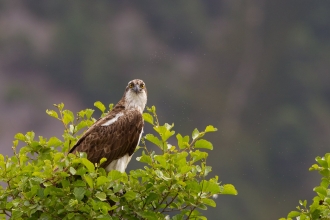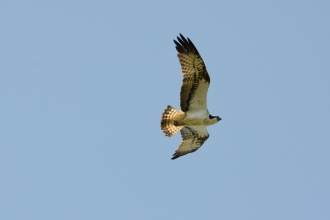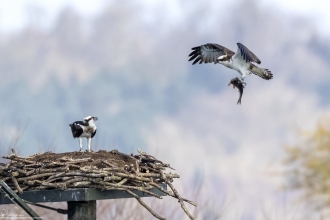Back from the brink
The Osprey was once a common sight in the UK. Intensive persecution and habitat loss during the 18th and 19th centuries led to the extinction of Ospreys as a breeding bird in England in 1847. A fragmented population remained in Scotland with breeding last recorded in 1916. Ospreys were still sighted as passage migrants and in 1954 the natural re-colonisation of Ospreys in Scotland began with individuals thought to have been Scandinavian in origin.
The re-colonisation of Ospreys in Scotland was slow and it was predicted it would take over 100 years before they were once again breeding in England. Thanks to pioneering conservation efforts, Ospreys have made a triumphant return to the UK, in what is widely celebrated as an incredible conservation success story. You can be part of that story.
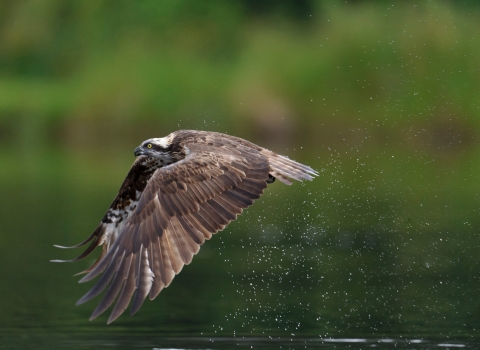
WildNet - Andrew Mason
Visiting the Rutland Ospreys
Meet our team of osprey experts, enjoy our shop and visitor centre, walk through the stunning Lyndon Nature Reserve and see the ospreys on their nest.
Our ospreys
All of the Rutland Ospreys, are fitted with two rings that allow us to identify the individual. The first one, on their left leg, is a metal ring, and the second, on their right leg, is a blue Darvic ring and each ring carries a unique set of numbers or code. As it wouldn’t be appropriate to recapture adult Ospreys to read the ring number on the metal ring, the number on the blue ring is enlarged enough to be read using a telescope or a camera with a suitable lens.
We refer to all of the Ospreys by their ring number, in order to avoid anthropomorphism, as all our Ospreys are wild birds, but we have made an exception and named the breeding female at the Manton Bay nest, Maya.
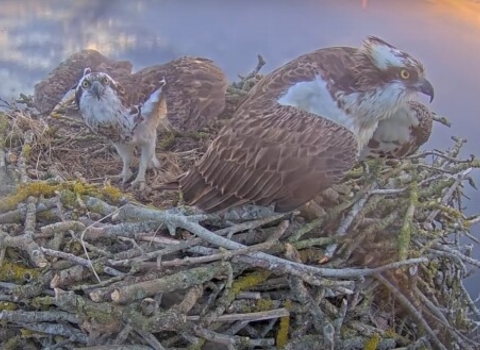
Live Nest Web Cam
Get a front row view of the ospreys at Manton Bay and watch them live on the nest
Ospreys at Rutland Water
In 1996, a translocation project began, which involved moving Osprey chicks from nests in Scotland and releasing them at Rutland Water with the aim to create a self-sustaining breeding population of Ospreys in central England.
The project reached a milestone in 2001, when 03(97), a male Osprey that had been translocated to Rutland Water Nature Reserve in 1997, raised a single chick with a metal ringed female from Scotland, close to the reservoir. This was the start of a huge conservation success story. Today, over 250 young Ospreys have fledged from nests in the Rutland Water area since the first chick in 2001.
We now have a self-sustaining population, with some fledged individuals even breeding in other parts of England and Wales. Most of the nests are situated on private land, however, one pair breed at Rutland Water Nature Reserve in Manton Bay, which can be viewed from a couple of bird hides at the Lyndon Visitor Centre and Nature Reserve. You can find out more about some of our Ospreys below.
Maya and 33(11) - Manton Bay
The Osprey nest in Manton Bay has been in use since 2007, but has been occupied since 2010 by the same female bird, presumably from Scotland, which we have nicknamed 'Maya'.
Maya arrived in the summer of 2009, and spent the summer bonding with a Rutland-fledged male Osprey, 32(05). The pair did not breed, but both returned in 2010. Unfortunately, in 2010 two male Ospreys went missing from Rutland, and 32(05) was one of them. However, she managed to pair up with a male Osprey, 5R(04) which was holding territory at the Manton Bay nest, and they successfully raised three chicks in 2010. At the time, Maya did not have a name and she was always referred to as the Manton Bay Female. Over the next few seasons, it was decided it would be easier to talk and write about her, and for people to relate to her if she had a name, and eventually we settled on Maya. Not only is it a lovely name, but it contains the first and last two letters in Manton Bay, and comes from the Greek Maia, who was the goddess of spring.
Over the three years (2010 to 2013) that Maya and 5R(04) bred together, they successfully raised 11 chicks. Of those 11 chicks, five of their young have since returned to Rutland!
In 2014, unfortunately, 5R(04) failed to return to Rutland after his migration. After weeks of anxious waiting, we came to realise, as did Maya that he was not going to come back. Ospreys face many challenges on migration, so sadly, we won't ever know what happened. With plenty of unpaired males in the area, Maya paired up with male 28(10) and did actually lay three eggs. But the nest suffered persistent intrusions from 33(11), and as a result, 28(10) was chased off and 33(11) took over the nest, kicking the eggs out in the process. After a while 33(11) and Maya did form a bond, but it was too late in the season for them to breed.
As we see Maya every day on the live webcam, we have come to know her very well as an individual. All Ospreys have unique, distinguishing characteristics, and Maya can easily be identified by the distinct markings on her head and face, in particular the brown cross that is visible on the back of her head. She has now raised 31 chicks since she first bred in 2010 and has provided us with a fabulous insight into the lives of breeding Ospreys.
33(11) fledged from one of the offsite nests in 2011 and his parents are male 03(97) and an unringed female. 33(11) was the only chick to fledge from that nest that year, so he did not have to compete for food, consequently becoming a strong, healthy juvenile and adult.
33(11) returned to Rutland for the first time as a two-year-old on 11th May 2013. He was first spotted in Manton Bay, by Project Officer Paul Stammers and volunteer Mick Lewin, then later was seen back at his natal nest, Site B. In 2014, he returned on 13th April and immediately began pestering Maya and 28(10) in Manton Bay. He did not give up until he chased 28(10) away and claimed the nest.
In 2015, both Maya and 33(11) returned to Manton Bay and bred successfully, raising three chicks, two of which have returned. 33(11) appears to enjoy spending time on the nest, more so than other males and will quite often take over incubation duties. Since 2016, they have raised an additional 24 chicks, including a record breaking four chicks in 2019 and 2020!
03(97) - Mr Rutland
We didn’t know it at the time, but of the eight birds which where translocated to Rutland Water Nature Reserve in July 1997, there was one who would go onto have a profound effect on the future of Ospreys in both England and Wales. His legacy and popularity, both with our volunteers and the media, would lead to him being nicknamed 'Mr Rutland'.
In 2001, 03(97), a male Osprey translocated to Rutland Water in 1997, raised a single chick with a metal ringed female at a nest on private land. This was the first year Ospreys had bred in central England for over 150 years! Since then, 03(97) continued to breed every year up to 2014, and raised a total of 32 chicks with three different females during that time. Mortality among young ospreys is very high; as many as 70% of young birds failing to survive the first two years of their life. And yet 40% of 03(97)’s offspring who are old enough to have returned to the UK, have made it back. Prior to this summer those 12 birds had, in turn, reared a total of 43 chicks between them, and, to date, four of those 43 have gone on to breed successfully. So aside from being a grandfather many times over, 03(97) was also a great grandfather to 15 young Ospreys.
Sadly, 03(97) is no longer breeding at Rutland Water after he failed to return in 2016 at the grand age of 18. However, his legacy lives on as several of his offspring are now breeding in the area. For example, male 33(11), which is the breeding male at the Manton Bay nest.
30(05), S1(15), 4K(13) - Satellite Tracking
30(05)
Female Osprey 30(05) fledged from 03(97)’s nest in 2005. She returned to Rutland in 2007 and bred for the first time in 2009, raising two chicks with translocated male 08(01), at a nest on private land. 30(05) and 08(01) raised a further six chicks from 2010 to 2012. Unfortunately, 08(01) did not return in 2013 and 30(05) did not breed in that year or in 2014. In 2015, however, she found a new mate and raised two chicks, and has been breeding since. She was fitted with a GPS tracker in 2013. In 2019 her tracker unfortunately stopped working, but we have gained a huge insight into her movements in Rutland, along her migratory route and in her wintering grounds in Senegal.
S1(15)
Male Osprey S1(15) fledged from Manton Bay in 2015. He was one of the first chicks that Maya and 33(11) the current Manton Bay pair had. He was ringed on the 30th June and left for his first migration on the 29th August 2015. S1(15) was first seen back in the UK in 2017, both in Poole Harbour then in Rutland. S1(15) was fitted with a GPS tracker in August 2018, but unfortunately in July 2020, we stopped receiving signals from S1(15)'s satellite tracker after he made a remarkable trip to the Netherlands and Germany. To read more about this follow the link below.
4K(13)
Male Osprey 4K(13) fledged from a nest on private land in 2013 and was ringed on 12th July 2013. He first returned to Rutland on 9th June 2015 and has been holding territory nearby, but has not yet successfully attracted a female. 4K(13) was fitted with a GPS tracker August 2018 and provided us with a to learn more about the behaviours and migration routes of the Rutland ospreys. It has provided us with a unique insight into his life, and although we do not currently satellite track any of our ospreys, you can read below about the unique information this tracking information has provided us.
For more information on satellite tracking, please follow the link below.
History of the Rutland Ospreys
Ospreys have been using Rutland Water as a stop-off during their migrations to and from Scotland for many years, almost as long as the reservoir has existed. However, despite a healthy and growing Scottish population, it was estimated that it could take at least 150 years for Ospreys to naturally re-colonise the whole of the UK. With some pioneering efforts and outstanding stakeholder working, the Rutland Osprey Project, which is managed by the Leicestershire and Rutland Wildlife Trust, in partnership with Anglian Water, was about to change all this, and see Ospreys soaring over central England once more...
Background
In 1954, following their official extinction in 1916, a pair of Ospreys attempted to breed at Loch Garten in the eastern highlands of Scotland. Since then, thanks to pioneering conservation efforts by the RSPB, imaginative solutions to conservation conflicts and huge support from locals, tourists and stakeholders, the Scottish population has grown to over 300 pairs. However, natural colonisation was slow. Young male Ospreys prefer to breed close to the sites where they first fledge. It’s over 60 years since the first Scottish breeding success and the majority of nests are still close to the original site. The population in Scotland, while expanding in size, does remain vulnerable to food shortages, disease and the vagaries of the weather. With all this in mind, it was estimated that it could take at least 150 years for Ospreys to naturally re-colonise the whole of the UK.
Ospreys at Rutland Water
Ospreys have been using Rutland Water as a stop-off during their migrations to and from Scotland for years, almost as long as the reservoir had existed. In 1986, the first efforts were made to attract Ospreys to stay and breed in the summer, with the installation of the first nesting platforms.
In 1994, a young female spent the summer at Rutland Water, as did a male Osprey, however despite hopes they failed to return the following year. In the same year, a number of artificial nesting platforms were built, guided by Roy Dennis of the Highland Foundation for Wildlife (now Roy Dennis Wildlife Foundation) – who is also a world leading expert on ospreys. Together with Reserve Manager Tim Appleton, the idea came of translocating Scottish Ospreys to Rutland Water. Anglian Water pledged financial support too, allowing long-term plans to be drawn up.
Taking flight
In June 1996, following 18 months of negotiation, a licence was granted by Scottish Natural Heritage, allowing up to twelve chicks to be removed from a choice of 35 nests in the eastern Highlands of Scotland. English Nature (now Natural England) were also included as the birds would have to be held captive on the reserve for a few weeks, involving more essential licenses. Between 1996 and 2001, a total of 65 Osprey chicks were translocated and released at Rutland Water Nature Reserve.
During the translocation, 6-week-old chicks were chosen from broods in accordance with the licence requirements, and driven overnight down to England. All donor nests were on private estates or on Forestry Commission land. The chicks were given two rings, as are all Rutland Osprey chicks; a coloured Darvic plastic ring to help with identification and a BTO ring. On arrival at Rutland Water, the Osprey chicks were placed in release pens. The pens provided wide-ranging views over the lagoons of the Reserve and the wider body of the reservoir. The chicks were fed twice or three times a day with pieces of fresh trout, introduced through small hatches to minimise disturbance.
Each bird had a small radio tag attached to its central tail feather, weighing 15g. These radios would allow the team to keep track of the young birds as they made their initial flights around Rutland Water.
When the birds were ready to be released, volunteers were posted discreetly at key vantage points around the reserve and the front of the pen was gently lowered. Often it was several hours before the birds launched themselves from their platforms, although some birds took advantage of their freedom immediately. It was always a tense moment, but the birds instinctively knew how to gain height, glide, change direction in the air.
After the chicks fledged, larger pieces or whole fish were provided on the platforms near the release pens. Until they migrated the young osprey came back to feed on the fish, just as their siblings in Scotland would have returned to their nests to take fish provided by their parents.
By the end of August or early September the young ospreys were often spending long periods of time away from the reserve. They were seen at various other lakes and rivers and usually returned each night to feed. Then, often on a bright, clear, breezy day, radio contact was lost with individual birds and they did not come back. On occasions this was witnessed by volunteers and members of the team. A bird would set out with determined purpose, flying south strongly and gaining height until it became a speck in the sky and then out of sight.
The story so far
During 2004, six non-breeding adult males, all of which had been translocated, were frequently recorded in Rutland, as well as the regular breeding pair. Based on the previous experience of Osprey translocation projects in North America, it had been expected that these males would have been able to attract passing females to stay and breed, but this was proving not to be the case. Early in 2005, a proposal was made to Scottish Natural Heritage and English Nature, requesting permission to collect a further batch of young ospreys from Scottish nests during 2005, but this time trying to select females.
By June 2005, permission was granted to complete a further translocation of Osprey chicks from Scotland to England in order to redress the gender imbalance in the Rutland population. Of the eleven chicks moved south nine of these turned out to be females. One disappeared very soon after release and the other ten migrated in September.
The long-term aim of the project was and is to create a completely self-sustaining breeding population. Now, we are confident we have sufficient adult ospreys and returning chicks to form a population which does not need to be further supported by translocation. It is encouraging that the population has swelled by way of some Scottish ospreys stopping off to breed, as was first hoped all those years ago. In most recent years, it is also encouraging that Rutland-fledged Ospreys are not only returning to breed here and in other parts of Britain, including Wales, but are also influencing populations overseas, as male S2(15), which fledged from the Manton Bay nest in 2015, is now breeding in The Netherlands. This just goes to show the scale of the impact the Rutland Osprey Project has had to local, national and international Osprey populations. The success of the Rutland Ospreys has directly led to similar Osprey translocation projects in Andalucia, in Spain and Maremma National Park, Italy.
Make a donation to the Rutland Ospreys
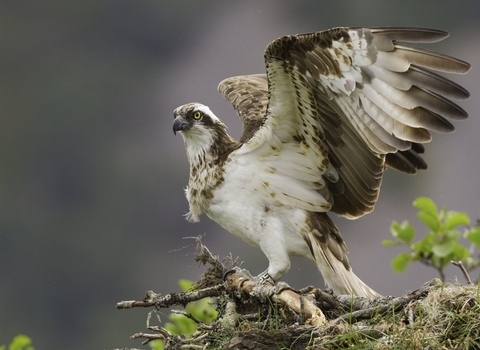
Osprey (Pandion haliaeetus) female on nest, Cairngorms Nat Park, Scotland. - Peter Cairns/2020VISION
About Ospreys
Ospreys are an incredible bird of prey. They live exclusively on fish, have a wingspan of just over 1.5 metres and can turn one of their toes a full 180 degrees! They dive into water feet-first to catch fish, using power talons to catch their prey. Ospreys in the UK migrate south to Africa every winter - a journey of over 3,000 miles to Senegal and the Gambia - and they do this without their parents. They can live for around 20 years.
2025 Season Updates
View our latest updates on our YouTube page to keep informed on the latest events at the Manton Bay nest this season.


